Part of a series of articles titled Whose Story is History? The Diverse History of Grand Canyon.
Article
Revolutionizing the River - Down the Colorado River Through Grand Canyon
- Duration:
- 5 minutes, 42 seconds
Loretta Jackson-Kelly of the Hualapai Tribe, Roland Manakaja of the Havasupai Tribe, and Leigh J. Kuwanwisiwma of the Hopi Tribe, talk about the cultural significance of Grand Canyon and the Colorado River and ask recreational boaters to treat what has been created with respect.
People have been traveling down the Colorado River through the Grand Canyon since time immemorial. The Colorado River is incredibly significant to many of the affiliated tribes at Grand Canyon. Oral histories tell us that many Ingenious individuals had traveled this route for thousands of years.
As European Americans expanded west and encroached on Indigenous homelands, they began traveling down the Colorado River. John Wesley Powell was the first European American to travel the Colorado River through Grand Canyon.
Botanists Elzada Clover and Lois Jotter became the first Euro-American women to successfully travel the route, and many followed in their footsteps. These trips were predominately expeditions to increase knowledge and scientific understanding.
With increased travel to the Grand Canyon by train and automobile, the potential for commercial tourism on the river became more possible.
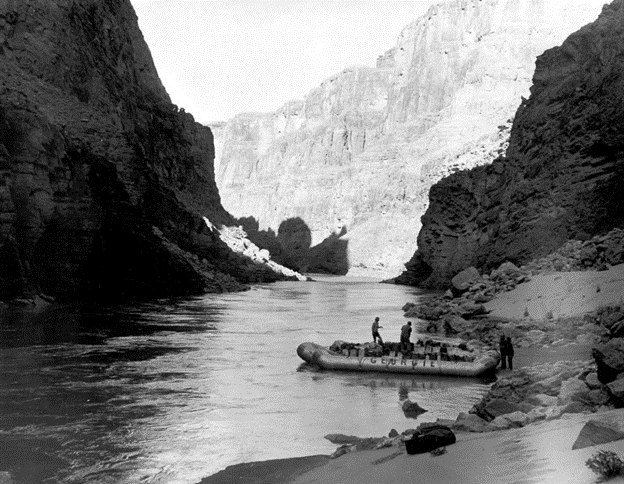
NPS
Georgie White changed the history of commercial river travel through the Grand Canyon. White was born in Oklahoma in 1911. After the tragic loss of her 15-year-old daughter in 1944, White made her way to the Grand Canyon.
Before White’s arrival, many had traveled down the river in various types of wooden boats. After WWII there was a surplus of rubber rafts and acquiring a large number of rafts was incredibly affordable.
White purchased a fleet of inflatable rafts and tied three together to stabilize them, calling it the G-rig. The rigs were 37 feet in length, 27 feet wide, and featured a motor at the rear. Rafts of similar style, although not always tied together, are still the most used method of commercial transport down the river.
White became the first woman to own a commercial river rafting company, Georgie’s Royal River Rats, which she started in 1953.
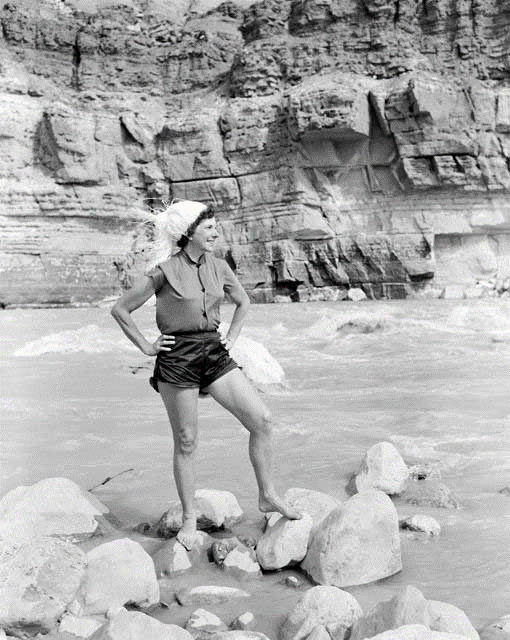
NAU Cline Library, Special Collections and Archives, Colorado River Plateau Digital Archives. Photo by Josef Muench. Call # NAU.PH.2003.11.4.3.H3828A
Over the course of her life, Georgie White witnessed large-scale changes to the rafting industry she helped develop. The 1950s, 60s, and 70s brought an incredible increase in commercial river rafting down the Colorado River. Access to the river had greatly expanded, and with that came heightened public interest. In 1955, about 70 people traveled the river. By 1972, over 16,400 people took the trip. This was the commercial river experience that brought Hanns Ebensten to the Grand Canyon.
Hanns Ebensten was born in Germany in 1923 and was raised by his Jewish father and Christian stepmother. After escaping Nazi Germany with his family, he lived in South Africa and then eventually immigrated to England. While in London, he met his life partner Brian Kenny. Both Ebensten and Kenny became fascinated with travel. The pair moved to New York and joined the travel industry.
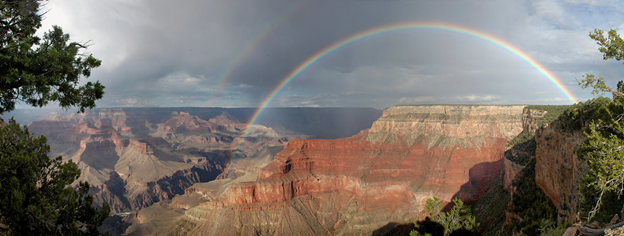
NPS
Ebsensten and Kenny wanted to visit the Grand Canyon. Hanns Ebensten said, “The last thing we wanted to do was a tour, because that was our business. But we wanted to go down the Grand Canyon of the Colorado River, see the most fabulous place in the United States, and you have to do that in a tour, so we had to join a tour, and of course we loved the Canyon, and it was marvelous.” While the pair enjoyed their time in the Canyon, Ebensten dreamed of creating a space for the gay community to travel together. In 1972 Hanns Ebensten started his own gay travel company, with the first official “gay men’s tour” down the Grand Canyon.
“I thought well gosh wouldn’t it be marvelous to do this for a group of congenial men . . . [who] could come and go down the Grand Canyon together. And so that was really how the gay travel started.” - Hanns Ebensten 2
Creating a space for LGBTQ+ people to travel and be safe together was unheard of at the time. Ebensten said, “We may have been a little unusual. We were certainly received very well, a little with suspicion at first.” Ebensten hoped that increased visibility of gay men travelling across the country and the world would in turn increase acceptance and understanding. He also hoped it would bring a stronger sense of confidence and self to the community. Over the next four decades, the LGBTQ+ travel industry would explode, with tours and experiences being offered all over the world. Ebensten said, “When I invented gay travel in 1972 it hadn't existed, and everything was done on a small scale. Now there are vast cruise ships filled with thousands of gay people going everywhere, so that is a tremendous change, I never envisioned such a thing.” Ebensten continued giving tours and writing books for LGBTQ+ travelers until his death on July 24, 2006.
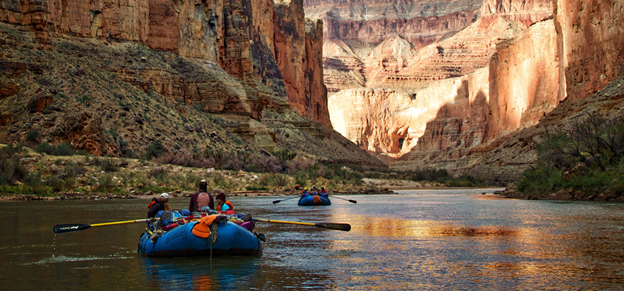
GRAND CANYON TRUST / AMY MARTIN
Georgie White and Hanns Ebensten helped make tourism on the Colorado River more inclusive. However, this success predominantly supported White individuals. This was not only true for people going down the river, but also for those who owned and operated the rafting companies. In 2001, Shana Watahomigie began training as a river guide with the Grand Canyon, making her the only Havasupai and Indigenous individual employed as a river permit ranger with the National Park Service at the time. Watahomigie said, “What I did through my storytelling was to make the river community aware of what it was lacking: an oral history of the canyon.” 3
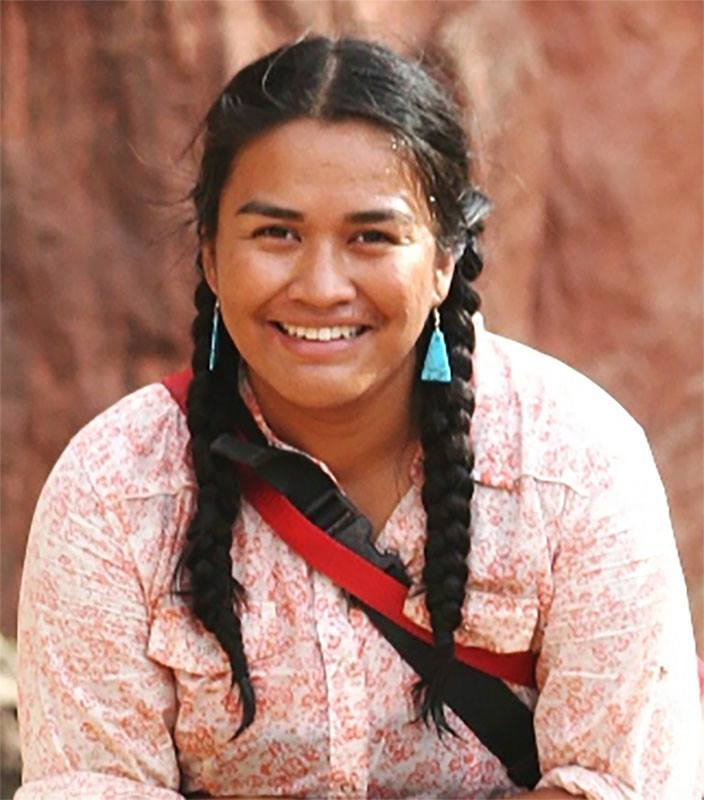
Image Courtesy of Nikki Cooley, Photographer Rob Elliott.

SERGIO BALLIVIAN
While representation has increased on the river, there is still work to be done to create a safe and welcoming space for all communities. This is what James Edward Mills, a journalist, outdoor professional, and advocate for encouraging Black people to get outdoors, experienced when he visited the Colorado River. In 2016, Mills obtained a permit to go down the river through the lottery system. With an increase in popularity, the National Park Service established a permit system for river travel. This process helped to maintain a safe number of individuals on the river at a time. While Mills was on his trip, the experienced river runners in his company observed that he was one of the only Black people they had ever seen on the river.
Mills wrote, “I had noticed the lack of diversity among the people we encountered from one end of the Grand Canyon to the other, but I wasn’t surprised.” 6
This observation lines up with visitation statistics. As of 2018, Black Americans made up only 2% of total national park visitors. Over the past few years, efforts have been made to change this. In 2017, President Barack Obama created a presidential memorandum calling agencies to improve on “Promoting Diversity and Inclusion in Our National Parks, National Forests, and Other Public Lands and Waters.” Even with these policies, there is still much work to be done in diversifying park narratives, staff, and visitation. Just as the Colorado River will continue to flow, more people will come to the park and bring a greater variety of stories and perspectives with them, but it will not happen by itself.
1 Nichols, Jeffery. "Daredevil Georgie White Ran Utah's Great Rivers." History Blazer, History to Go, Utah: An Official Website, August 1995. https://historytogo.utah.gov/daredevil-georgie-white/.
2 "Hanns Ebensten: The founder of gay travel - HEtravel.com - AlysonAdventures.com." He Travel, Jun 9, 2010. Youtube video, https://www.youtube.com/watch?v=Aj3wK-rSxI0.
3Ross, Tracy. "River Keeper." Backpacker, October 2, 2008. https://www.backpacker.com/news-and-events/river-keeper/.
4 Callaghan, Anna. "The First Licensed Native Guide in the Grand Canyon." Outside. May 24, 2018. https://www.outsideonline.com/outdoor-adventure/water-activities/river-guides/.
5 Mathis, Mary and Cody Nelson. "Episode 2: Grand Canyon." Parks Podcast. 2021. https://podcasts.apple.com/us/podcast/episode-2-grand-canyon/id1554571337?i=1000532551821.
6 Mills, James Edward. "Here's how national parks are working to fight racism," National Geographic, Jun 23, 2020. https://www.nationalgeographic.com/travel/national-parks/article/more-diversity-how-to-make-national-parks-anti-racist.
Riggs, Sarana. "Nikki Cooley: The Colorado River, A Lifeline of Mother Earth." Grand Canyon Trust, June 1, 2020. https://www.grandcanyontrust.org/blog/nikki-cooley-colorado-river-lifeline-mother-earth.
Youngs, Yolonda. "Running the River." Nature, Culture, and History at the Grand Canyon, Arizona State University. https://grcahistory.org/history/colorado-river/running-the-river/.
Last updated: October 11, 2024
